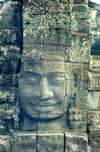
I learned the secret to traveling in a country plagued with terrorists: Travel during the World Cup. You may think you are at the end of the earth and have abandoned civilization as you know it, but if you look into one of those little shacks, you will find a bunch of men crowded around a little television drinking beer and cheering whenever anyone makes a goal. Terrorists around the world will declare a cease-fire to watch their soccer. The Tamil tigers are similarly occupied during the major cricket matches.
I wasn't having a good time in Bangkok. I heard that it has the highest average temperature of any major city in the world. I sweated through my shirt the moment I got off the plane at 11 at night. I thought to myself, "Lord help us when the sun rises." It is also packed with tourists, who were either backpackers looking for cheap parties or older guys looking for sex. After a couple of days of tolerating this, I was ready to leave. I walked down the street with all the embassies, and checked with Laos, which could give me a $60 travel visa in two weeks. Vietnam would give me an $80 visa in a week. Then I saw the slightly run-down Cambodian embassy. I walked in, and the official said that the border crossing at nearby Poipet opened up a month ago. This meant that I could simply take a bus to Cambodia. Visas were $20 and could be picked up after lunch. Thinking about the Cambodian elections next month, which last year resulted in grenade attacks in the capital, I asked, "Is it safe?" "Sure it is," he replied. Being in a weak frame of mind from the heat and pollution, I handed over the $20.
Within a few hours, I had my Cambodian tourist visa and was on the train to Chachoengsao, a town partway to the Cambodian border. Chachoengsao didn't have many attractions according to my Lonely Planet, but I just needed to get out of Bangkok. I arrived in a tiny town with no obvious accommodations. I talked to a couple of guys in a little restaurant, and asked them where was the "Panom Garden" hotel, which was mentioned in my guide book. They couldn't speak English, but they figured out what I wanted and directed me to a bus station. After waiting there for twenty minutes or so, one of the guys from the restaurant appeared and motioned me to his pickup truck. I hopped in, and he said, I think, that he had a girlfriend in the next town and Panom Garden was on the way. Perfect. After driving for fifteen minutes or so, I asked him how far the hotel was, and he turned to me and said "forty kilomet". I was extremely pissed at the Lonely Planet. After another fifteen minutes or so, we stopped at Panom Garden, a hotel along the highway and with no neighbors in sight. He walked me in to the hotel, and the English-speaking proprietor came out and offered me a room for about $15. This was far more than I wanted to spend, but what choice did I have? I thanked my friend, who politely refused my offer of payment and drove off. After he left, a young woman in a tight cheongsam walked into the lobby, and the smiling proprietor turned to me and said, "We have beautiful ladies to sing for you!" A brothel. Great. My ire at the Lonely Planet increased a notch.
After washing up, I went to the restaurant for dinner. The large dining room had a stage with a couple of musicians backing a woman singer. I went to a table in the back of the room and ordered some fried rice. After her short set, the singer went to sit at a table full of what appeared to be Chinese businessmen, and another woman got up to start singing. By the time I was done eating, four or five young singers were distributed among tables around the room.
The next morning, I wanted to catch the bus to Aranya Prathet, which was the Thai side of the Cambodian border crossing. Fortunately, Panom Garden, even though it was in the middle of nowhere, happened to be on the highway leading to Aranya Prathet. The people at the hotel told me to wait along the highway for the bus. So I walked down the highway a couple of hundred feet until I got to a plausible bus stop - a bush with two Thais waiting by it. I discovered that one young man was headed in the same direction. After watching various vehicles go by for a couple of hours, the guy flagged down the right one, and I got on with him.
I got to the border without incident. I walked the fifty feet from the Thai side to the Cambodian side, and I headed to the "bus stop", where there were dozens of pickup trucks. I told them that I wanted to go to Siam Reap, and one offered to take me there for 500 Thai baht. I boarded his truck, and we circled around the town for an hour looking for more passengers. When it looked like it would be difficult to find more passengers, the driver's assistant turned to me and asked for 100 more baht. I refused. He stuttered, in English, "You are very bad." He said this several more times, and I kept on refusing to give them more money. I began to wonder about the wisdom of trying out the new border crossing of a country likely to erupt in civil war next month. Eventually, we found a few more passengers, a few of whom sat in the truck bed.
When we got to Sisophon, which was less than a quarter of the way to Siam Reap, all the passengers got off and the driver told me, "We sleep here tonight." It was pouring rain and Sisophon was a remote, muddy Cambodian town. I protested loudly, and stayed under an awning near the truck. After a couple of hours, they managed to find enough passengers, including a Japanese backpacker and two Cambodians. The four of us were stuffed into the backseat of another pickup truck.
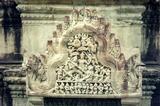 Actually, I was very lucky. I met his brother the next
morning and he was an excellent guide. He spoke fluent
English and knew the sites well. In addition to the park fee,
licensed guides are required to tour the Angkor complexes.
You would ride around the park on the back of the guide's
motorcycle (or car if you had a big party), and he would
drop you off wherever you wanted. The park went on for kilometers
in every direction. It would have been
impossible to view the ruins on foot, and you'd probably get blown
up by a land mine. I paid $40 for a three-day pass, and the
driver asked for $6 per day. He told me that he hadn't worked
in a year. Civil war does deter tourists.
Most of the tourists at Angkor were Cambodians.
Actually, I was very lucky. I met his brother the next
morning and he was an excellent guide. He spoke fluent
English and knew the sites well. In addition to the park fee,
licensed guides are required to tour the Angkor complexes.
You would ride around the park on the back of the guide's
motorcycle (or car if you had a big party), and he would
drop you off wherever you wanted. The park went on for kilometers
in every direction. It would have been
impossible to view the ruins on foot, and you'd probably get blown
up by a land mine. I paid $40 for a three-day pass, and the
driver asked for $6 per day. He told me that he hadn't worked
in a year. Civil war does deter tourists.
Most of the tourists at Angkor were Cambodians.
 My guide told me that Banteay Srei was the most beautiful
ruins complex. If I wanted to go, he would have to charge
an extra $4 for the extra petrol, as it was 20
kilometers north of Angkor Wat. This area used to be
under the Khmer Rouge's control, so the road up used to be
heavily mined. Until last year, the only way to get here was
by helicopter. My guide assured me that British minesweepers
had cleared out the road recently. However, one should not
stray from the main paths.
We went, and I think he was right about its beauty.
The material was obviously from a different source than
that of the rest of the ruins. The stones
were reddish-brown instead of gray.
My guide told me that Banteay Srei was the most beautiful
ruins complex. If I wanted to go, he would have to charge
an extra $4 for the extra petrol, as it was 20
kilometers north of Angkor Wat. This area used to be
under the Khmer Rouge's control, so the road up used to be
heavily mined. Until last year, the only way to get here was
by helicopter. My guide assured me that British minesweepers
had cleared out the road recently. However, one should not
stray from the main paths.
We went, and I think he was right about its beauty.
The material was obviously from a different source than
that of the rest of the ruins. The stones
were reddish-brown instead of gray.
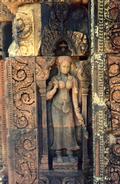
| The carvings were perfect. It is hard to imagine that they were over 800 years old. |
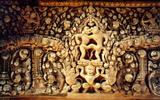
|
Siam Reap is a pleasant place to stay. In fact, the president of Cambodia often stays there, possibly to avoid the gunfire and noise of Phnom Penh. In fact, he must have arrived on my second day in Siam Reap. The roads around his home were closed and heavily guarded. I thought it was strange that he would be away from the capital so close to elections, unless the Khmer Rouge were coming back to the capital to influence the outcome. A little river divides the town, and it is possible to walk everywhere. There is not much to see here. There are many little restaurants, some catering to tourists and charging dollars. I had a better time eating at the local places with no menus. I learned how to say "fried fish", "soup", and "beer". A full dinner without beer would be about 50 cents, while the beer could add a dollar to the cost. Breakfasts were usually little sandwiches of cucumbers, chilis, and sometimes pork on a fresh baguette.
I met several backpackers who had stayed in Siam Reap for months. They spend their days smoking cheap pot (which is sold in fat bundles in the market) and head out to the monuments for sunset. You can get a room with a shared bath for about $1 a day. I mentioned my puzzlement at this choice of cities to another tourist, and he told me that some "hardcore" backpackers just like to find the cheapest and shittiest place they could and stay for months. Life was pretty easy in Siam Reap, but I can imagine getting credibility in the backpacker community by being able to say that one stayed in Cambodia for so long.
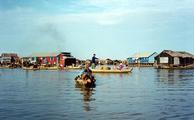 I wasn't sure how to travel across Cambodia.
According to the out-of-date Lonely Planet, the buses
were subject to banditry, the train tracks were destroyed
by the Khmer Rouge, and the boats were shot at by angry
Vietnamese fishermen. I opted for the speedboat on
the Tonle Sap, a narrow lake that traverses the country
from Siam Reap to Phnom Penh.
The boats leave from a town in the lake that is entirely on stilts.
We took a little motorboat out to the speedboat
dock, weaving through the various households and shops in the
water. It was a fun ride, costing
about $20. I sat on top of the boat with a few other guys,
while the rest of the passengers sat in the seats inside.
The Cambodian sun was incredibly fierce, but the heat was
masked by the wind whipping past us, so we were all pretty
sunburned at the end of the four-hour trip.
I wasn't sure how to travel across Cambodia.
According to the out-of-date Lonely Planet, the buses
were subject to banditry, the train tracks were destroyed
by the Khmer Rouge, and the boats were shot at by angry
Vietnamese fishermen. I opted for the speedboat on
the Tonle Sap, a narrow lake that traverses the country
from Siam Reap to Phnom Penh.
The boats leave from a town in the lake that is entirely on stilts.
We took a little motorboat out to the speedboat
dock, weaving through the various households and shops in the
water. It was a fun ride, costing
about $20. I sat on top of the boat with a few other guys,
while the rest of the passengers sat in the seats inside.
The Cambodian sun was incredibly fierce, but the heat was
masked by the wind whipping past us, so we were all pretty
sunburned at the end of the four-hour trip.
I didn't do much in Phnom Penh, other than seeing "the killing fields", getting my camera waterlogged and broken in a monsoon, purchasing my expensive Vietnam visa, and getting really sick. I would advise people to be more careful with street vendor food than I was. It's hard to feel affection for a town when the only tourist attraction you see are the skulls of its slaughtered citizens.